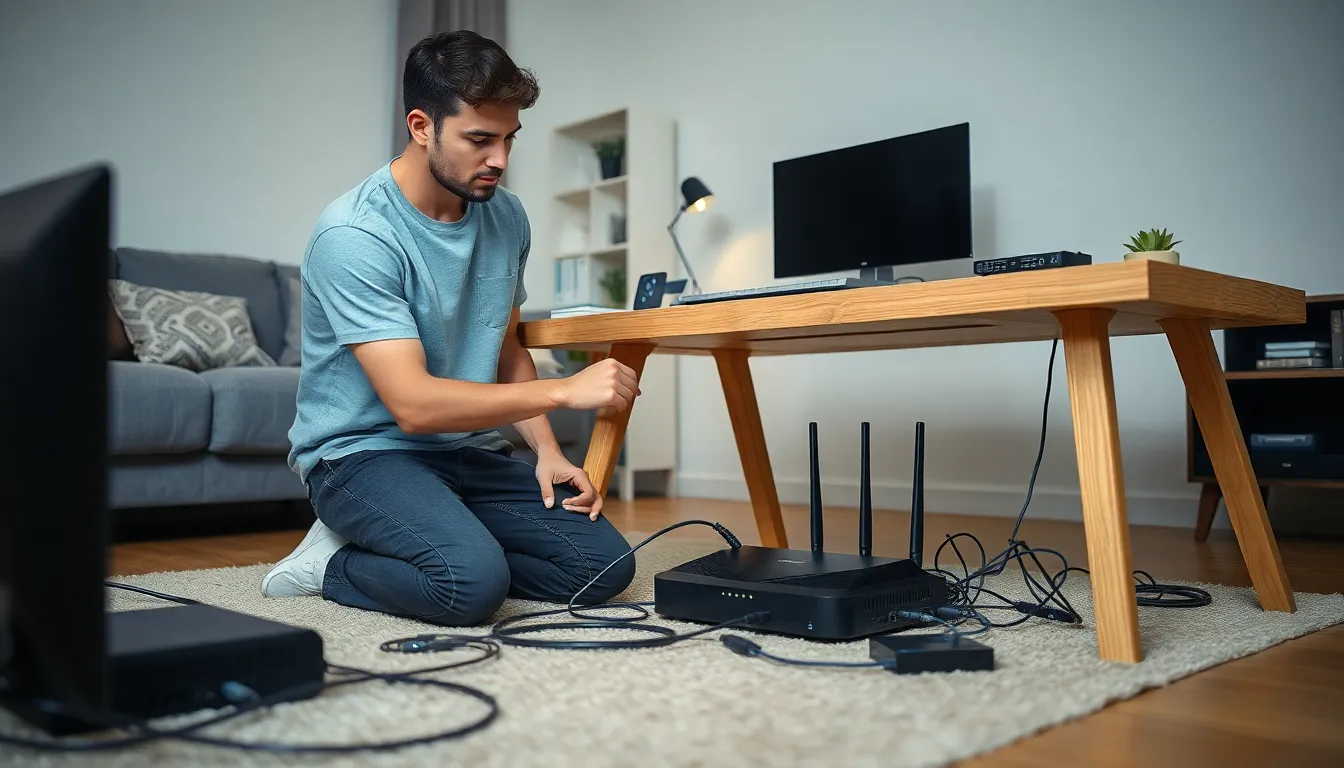In today’s digital age, a reliable home network is essential for everything from streaming movies to working from home. As more devices connect to the internet, setting up an efficient and secure network becomes crucial. A well-structured home network not only enhances connectivity but also protects personal data from potential threats.
Whether you’re a tech-savvy individual or a beginner, understanding the basics of home network setup can make a significant difference. With the right guidance, anyone can create a seamless and robust network tailored to their needs. This article will walk through the key steps to establish a strong home network that meets modern demands while ensuring security and ease of use.
Table of Contents
ToggleUnderstanding Home Networks
A well-functioning home network consists of several components and types that cater to different needs. Understanding these elements helps in creating a reliable and efficient network for various digital activities.
Components of a Home Network
- Router: A router directs data traffic between the internet and connected devices. It manages network connections and provides security features such as firewalls.
- Modem: A modem connects a home network to an Internet Service Provider (ISP). It converts signals for internet access, enabling devices to connect online.
- Access Points: Access points extend wireless coverage within a home. They enhance connectivity in larger spaces, allowing multiple devices to connect seamlessly.
- Network Cables: Ethernet cables facilitate wired connections between devices, providing stable and high-speed internet access.
- Devices: Devices include smartphones, laptops, smart TVs, and IoT products, all of which connect to the home network for various functions.
Types of Home Networks
- Wired Networks: Wired networks use Ethernet cables for a direct connection. They offer faster speeds and more reliable connections, ideal for gaming and video streaming.
- Wireless Networks: Wireless networks use Wi-Fi for connectivity. They provide flexibility and ease of movement, suitable for everyday internet use.
- Mesh Networks: Mesh networks consist of multiple nodes to blanket larger areas with Wi-Fi. They eliminate dead zones and ensure a robust signal throughout a home.
- Hybrid Networks: Hybrid networks combine wired and wireless elements. They harness the speed of wired connections with the convenience of wireless access, optimizing performance across devices.
Preparing for Setup

Preparing for a home network setup involves assessing requirements and selecting suitable equipment. This process ensures an efficient and secure network tailored to individual needs.
Assessing Your Needs
Assessing network needs involves identifying usage patterns and device connections. Consider the following factors:
- Number of devices: Count all devices that will connect, including computers, smartphones, smart TVs, and gaming consoles.
- Internet usage: Determine what activities the network will support, such as streaming, online gaming, or remote work.
- Coverage area: Measure the space that needs coverage to ensure a strong signal throughout the home.
- Speed requirements: Evaluate necessary bandwidth to support multiple users and devices simultaneously.
Choosing the Right Equipment
Choosing the right equipment is crucial for an effective home network. Consider these components:
- Router: Ensure the router supports the latest standards (e.g., Wi-Fi 6) for optimal speed and capacity.
- Modem: Select a modem compatible with your Internet Service Provider (ISP) and capable of handling high-speed connections.
- Access points: Decide whether to include additional access points for larger homes to enhance coverage.
- Network cables: Use high-quality Ethernet cables for wired connections, preferably Cat6 or higher for future-proofing.
- Mesh systems: Explore mesh network systems to eliminate dead zones in larger or multi-story homes.
By assessing needs and choosing appropriate equipment, homeowners set a solid foundation for their networks.
Step-by-Step Guide to Setup Home Network
This guide details the essential steps for setting up a home network effectively. Each stage ensures a stable and secure environment for connected devices.
Connecting Your Modem
- Locate the modem. Place it in a central location to maximize signal reach.
- Connect to the internet. Use a coaxial, DSL, or fiber-optic cable to link the modem to the wall outlet.
- Link power. Plug the modem into a power source, using the appropriate adapter.
- Check lights. Ensure the lights on the modem indicate a connection, often showing green for an active internet signal.
Setting Up the Router
- Connect to the modem. Use an Ethernet cable to connect the router’s WAN or Internet port to the modem’s LAN port.
- Power the router. Plug the router into a power outlet to turn it on.
- Position properly. Place the router in a high, central area to optimize Wi-Fi coverage across the home.
- Check indicators. Verify that the router’s power and WAN lights are lit up, confirming a successful connection.
Configuring Network Settings
- Access the router interface. Open a web browser and type the router’s IP address, typically found on the device label or manual.
- Log in securely. Use the default username and password provided, changing them immediately for security.
- Set up Wi-Fi network. Create a network name (SSID) and choose a strong password to protect the connection.
- Adjust settings. Configure additional options like guest networks, parental controls, and firewall settings as needed.
- Save changes. Ensure all configurations are saved before exiting the router interface. Restart the router to apply settings.
By following these steps, homeowners can create a strong, secure network ready for various digital activities.
Securing Your Home Network
Securing a home network is essential to protect sensitive data and prevent unauthorized access. Implementing best practices and utilizing security protocols enhances safety and reduces vulnerabilities.
Best Practices for Network Security
- Change Default Credentials: Update the router’s default username and password. Using unique credentials prevents unauthorized access.
- Use Strong Passwords: Create complex Wi-Fi passwords that include uppercase and lowercase letters, numbers, and symbols. Aim for a minimum of 12 characters.
- Enable Network Encryption: Activate WPA3 encryption for added security. If unavailable, use WPA2, as it is stronger than WEP.
- Update Firmware Regularly: Check for and install firmware updates for routers and devices. Updates address security vulnerabilities and enhance performance.
- Enable Network Firewall: Use the built-in firewall on the router to block unauthorized traffic. Adjust settings based on network needs.
- Disable WPS: Disable Wi-Fi Protected Setup (WPS) to prevent hackers from exploiting vulnerabilities associated with easy connections.
- Limit Guest Access: Use a separate guest network for visitors. This keeps household devices isolated and minimizes exposure.
- Monitor Connected Devices: Regularly check the list of connected devices. Disconnect any unfamiliar devices immediately.
Common Security Protocols
- WPA3: The latest security protocol that provides enhanced protection against unauthorized access and password guessing.
- WPA2: The second-best option, widely used, still reliable but vulnerable to certain attacks compared to WPA3.
- WEP: An outdated protocol with significant security flaws. Avoid using WEP in modern home networks.
- VPN: A Virtual Private Network adds an extra layer of security by encrypting internet traffic, shielding personal information from prying eyes.
- MAC Address Filtering: This technique restricts network access based on device MAC addresses. While not foolproof, it adds a layer of security against unauthorized devices.
- IP Address Filtering: Similar to MAC filtering, IP filtering restricts access to specific IP addresses. This enhances control over network access.
By implementing these best practices and utilizing strong security protocols, homeowners can significantly reduce the risks associated with their home networks.
Troubleshooting Common Issues
Addressing network problems promptly ensures a smooth home online experience. Common issues often arise with connectivity and device compatibility.
Connectivity Problems
Connectivity problems frequently manifest as slow internet speeds or complete disconnections. When encountering these issues, consider these steps:
- Restart Devices: Restart the router and modem to reset the connection.
- Check Cables: Inspect network cables for damage and ensure all connections are secure.
- Signal Interference: Identify and resolve potential interference sources, like walls or electronic devices.
- Network Congestion: Limit the number of connected devices during peak usage times to enhance performance.
- ISP Issues: Contact the Internet Service Provider for outages or slow service in the area.
By following these steps, users can often resolve connectivity issues quickly.
Device Compatibility Issues
Device compatibility issues can hinder the setup and functioning of a home network. To address these concerns, apply these strategies:
- Check Specifications: Ensure all devices meet the network standards, such as Wi-Fi 5 or Wi-Fi 6.
- Update Drivers: Keep device drivers up-to-date to fix bugs and improve connectivity.
- Compatibility Mode: Use compatibility mode settings on routers for older devices.
- Network Band Settings: Configure devices to connect to the appropriate frequency (2.4GHz or 5GHz) for optimal performance.
- Factory Reset: Factory reset problematic devices when necessary to restore original settings.
By systematically evaluating compatibility, users can enhance their home network experience.
Establishing a reliable home network is essential in today’s connected world. By understanding the various components and types of networks available, homeowners can tailor their setups to meet specific needs. Careful selection of equipment and following best practices for security can significantly enhance both performance and safety.
Troubleshooting common issues ensures a seamless digital experience. With the right approach, anyone can create a robust home network that supports streaming, remote work, and more while safeguarding personal data. Embracing these strategies leads to a more efficient and enjoyable online environment for every household.




